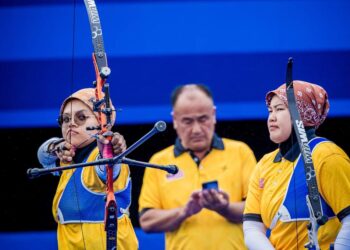Developing a strong technique takes time, coaching and the one ingredient that nobody can ignore: Practice. Fixing little mistakes, or nuances, that might make somebody less accurate is important – and who better to point them out than the archers and coaches who have been there, fixed that?
Here’s what some of the world’s most accurate athletes had to say about fixing the most common mistakes when shooting a recurve bow.
1. LOSING AIM
“Even though an archer is aiming at a certain point at full draw, they often lose the aiming point when they release,” said London 2012 Olympic Champion Ki Bo Bae.
She pointed out the shape of her sight – a circle with a pin in the middle, then added: “Many archers think about the line of the circle – but they must only focus on the centre sight pin and where it is on the target.”
2. AIMING TOO HARD
USA head coach Kisik Lee warned, though, that overaiming can be just as dangerous: ”Too much thinking, and aiming too much. The two are tied together. If you’re thinking too much, you’ll be aiming too much, and then holding longer.”
That, he said, is only fixed with training – and, as Italian coach Wietse van Alten added, taking practice to the competition field: “Don’t do something extra on the shooting line. You need to be doing things absolutely the same.”
3. HOLDING TOO LONG
Shot routine and consistent timing is, many archers and coaches will say, the key to accuracy. Many of the top athletes will spend little to know time at full draw – but the most important thing is to maintain your usual timing.
“One of the biggest challenges is bringing the same timing you have in practice to competition,” said Bernardo Oliveira.
“You see a lot of people holding the shot much longer. People are apprehensive, and it’s hard to keep up that inner confidence. In a competition, you’re being tested and if you’re not really, really confident it’s so hard to keep up that timing.”
4. FIGHTING THE WIND
“I think it’s the worst mistake because it’s the thing you can’t control. You always fight with the wind – but you don’t have to fight, just understand it and shoot,” said Ana Maria Rendon.
She said that in Colombia, where there isn’t too much wind, the team practises aiming off to learn how to appreciate arrows moving across the target face.
“It gives you the confidence that if you aim in the red, the arrows land in the yellow.”
USA coach Mel Nichols added that it’s important that wherever you aim, you trust that aiming spot – and, no matter the amount of wind, you deliver the best possible shot: “It’s when you have to aim off that people start not trusting themselves.”
5. FOCUSING ON EQUIPMENT
It’s easy to get lost in the newest or shiniest kit – but it’s the age old mistake.
“First focus on your form, and making it as repeatable as possible before worrying about the nuances of equipment. Generally speaking, the equipment will outshoot the shooter,” said arrow engineer George Tekmitchov.
“The best archers in the world spend 95% of their effort on physical and mental and perhaps the remainder on equipment, if that.”
6. LOSING BACK TENSION
One of the toughest things to fix is a release hand that jumps forward when the fingers let go of the string, rather than flowing backwards.
“More than just holding the stringer in the fingers, the strength in the scapula must be there. It’s all in the movement of the shoulders,“ explained World Archery Champion Kim Woojin.
Naomi Folkard added: “People change the muscles they use when they get to full draw. It’s important to keep the movement the same, understand the process of expansion and deliver a well-executed shot.”
7. NO PUSH
“Coaches always said to me you had to pull, but nobody said you had to push – and how to push,” said Lisa Unruh. “I think that’s the most common mistake.”
She was referring to pulling with the back, draw hand and shoulder – and pushing with the bowhand.
“It’s a feeling. I push more when I shoot indoor. It used to be when I changed to the outdoor season, I pushed more at the beginning, but after a few weeks I would lose the feeling.”
“Last year, I realised how important it was for me outdoors, too – and realised I had to focus on the push.”
Last year – 2016 – was also when Lisa finished second at the Olympic Games. Coincidence?
8. FINISHING AT THE CLICKER
Target panic, gold shyness or, as we’ve recently found out the Koreans call it, clicker disease is a horrible thing to experience as a recurve archer. Not being able to execute when on the middle, having the confidence to push through and deliver an arrow as your want to is often a symptom of not learning to use a clicker correctly.
“The clicker is not the end of the shot but the beginning,” said Sjef van den Berg, who finished fourth at Rio 2016. “The way to fix it is to focus on moving your elbow and bow hand away from each other, and not to relax before the shot is actually done.”
And when does the shot finish? Well after the arrow has landed, Sjef said.
9. CHASING PERFECTION
“The technique you use is your technique alone. It is particular to each person. My technique is very particular to me,“ said world number one JC Valladont.
He gave only three key ingredients for a strong shot.
“While everyone’s technique is different, the central aspects [of the world’s best] are the same. We shoot in one movement [of the back shoulder], keep a still posture and a strong front arm towards the target.”
JC added that while many people make extra movements after the shot, that’s really all for show: “The arrow is already flying. It is the millisecond when you open the fingers that is the most critical.”
Thanks to John Stanley, who contributed heavily to this article.





























